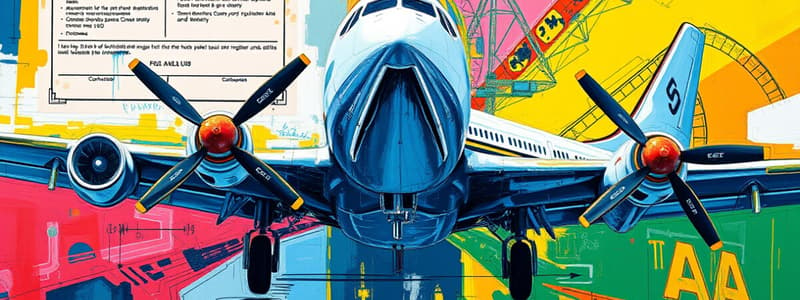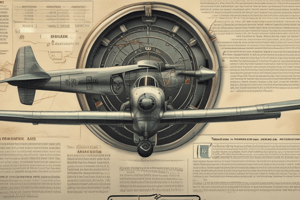Podcast
Questions and Answers
What are the three types of aviation products the FAA certifies?
What are the three types of aviation products the FAA certifies?
Aircraft, aircraft engines, and propellers
What are airworthiness standards?
What are airworthiness standards?
Developed to help ensure that aviation products are designed with no unsafe features.
What is a Type Certificate?
What is a Type Certificate?
Specifies the important design and operational characteristics of the aircraft, aircraft engine, or propeller.
What is standard airworthiness?
What is standard airworthiness?
What is special airworthiness?
What is special airworthiness?
What are the four forces that act upon an aircraft in relation to straight and level, unaccelerated flights?
What are the four forces that act upon an aircraft in relation to straight and level, unaccelerated flights?
What is thrust?
What is thrust?
What is drag?
What is drag?
What is weight?
What is weight?
What is lift?
What is lift?
What is a fuselage?
What is a fuselage?
What are wings?
What are wings?
What are ailerons?
What are ailerons?
What are flaps?
What are flaps?
What are trim tabs?
What are trim tabs?
What does an empennage consist of?
What does an empennage consist of?
What is the rudder?
What is the rudder?
What is landing gear?
What is landing gear?
What is the powerplant?
What is the powerplant?
What does the engine do?
What does the engine do?
What does the propeller do?
What does the propeller do?
What does AOA stand for?
What does AOA stand for?
What are the subcomponents of an airplane?
What are the subcomponents of an airplane?
What is the airframe?
What is the airframe?
What is the primary function of an aircraft electrical system?
What is the primary function of an aircraft electrical system?
What are flight controls?
What are flight controls?
What do aircraft brakes consist of?
What do aircraft brakes consist of?
What is a truss structure?
What is a truss structure?
What is a monocoque structure?
What is a monocoque structure?
What is a semi monocoque structure?
What is a semi monocoque structure?
In 2005, what percentage of new aircraft were constructed of composite materials?
In 2005, what percentage of new aircraft were constructed of composite materials?
What are composite materials?
What are composite materials?
What are the most common reinforcing fibers in an aircraft?
What are the most common reinforcing fibers in an aircraft?
What are the advantages of composites?
What are the advantages of composites?
What are the disadvantages of composites?
What are the disadvantages of composites?
What happens when an airplane is struck by lightning?
What happens when an airplane is struck by lightning?
What are performance instruments?
What are performance instruments?
What are control instruments?
What are control instruments?
What are navigation instruments?
What are navigation instruments?
What is the Global Positioning System?
What is the Global Positioning System?
Flashcards
Airworthiness standards
Airworthiness standards
Ensures aviation products are designed to minimize unsafe features.
Type Certificate
Type Certificate
Includes a data sheet outlining design and operational characteristics.
Standard airworthiness certificate
Standard airworthiness certificate
Issued for normal, utility, acrobatic, or transport category aircraft.
Special airworthiness certificate
Special airworthiness certificate
Issued for restricted, limited category aircraft, and light sport aircraft.
Signup and view all the flashcards
Thrust
Thrust
Forward force that counters drag.
Signup and view all the flashcards
Drag
Drag
Rearward force opposing thrust, caused by airflow disruption.
Signup and view all the flashcards
Weight
Weight
Gravitational force pulling the aircraft downward.
Signup and view all the flashcards
Lift
Lift
Force counteracting weight; from dynamic airflow over the wings.
Signup and view all the flashcards
Fuselage
Fuselage
Central body designed for crew, passengers, and cargo.
Signup and view all the flashcards
Wings
Wings
Primary lifting surfaces essential for flight.
Signup and view all the flashcards
Ailerons
Ailerons
Wing control surfaces that facilitate rolling motion.
Signup and view all the flashcards
Flaps
Flaps
Increase lift for takeoffs and landings by moving downwards.
Signup and view all the flashcards
Trim tabs
Trim tabs
Small surfaces that reduce control pressure on larger control surfaces.
Signup and view all the flashcards
Rudder
Rudder
Controls yaw (left/right).
Signup and view all the flashcards
Landing gear
Landing gear
Supports the aircraft on the ground.
Signup and view all the flashcards
Propeller
Propeller
Converts engine rotation into thrust.
Signup and view all the flashcards
Airframe
Airframe
Withstands aerodynamic forces and supports the weight of the aircraft.
Signup and view all the flashcards
Electrical system
Electrical system
Generates, regulates, and distributes electrical power.
Signup and view all the flashcards
Flight controls
Flight controls
Manage altitude and aircraft flight path.
Signup and view all the flashcards
Braking system
Braking system
Uses caliper pads and rotors to decelerate the aircraft.
Signup and view all the flashcards
Truss structure
Truss structure
Uses welded tubing to form a stiff framework.
Signup and view all the flashcards
Monocoque structure
Monocoque structure
Uses stressed skin to bear loads.
Signup and view all the flashcards
Semi-monocoque structure
Semi-monocoque structure
Combines substructure elements with stressed skin for added support.
Signup and view all the flashcards
Common reinforcing fibers
Common reinforcing fibers
Fiberglass and carbon fiber.
Signup and view all the flashcards
Performance instruments
Performance instruments
Reveal the aircraft's performance metrics.
Signup and view all the flashcards
Control instruments
Control instruments
Display immediate attitude and power changes.
Signup and view all the flashcards
Navigation instruments
Navigation instruments
Help ascertain the aircraft's position.
Signup and view all the flashcards
Global Positioning System (GPS)
Global Positioning System (GPS)
A satellite-based navigation system.
Signup and view all the flashcardsStudy Notes
Aviation Product Certification
- FAA certifies three types of aviation products: aircraft, aircraft engines, and propellers.
- Airworthiness standards ensure aviation products are designed to minimize unsafe features.
Type Certificates
- A Type Certificate includes a data sheet that outlines key design and operational characteristics of certified aviation products.
Airworthiness Certificates
- Standard airworthiness certificates are white and issued for normal, utility, acrobatic, commuter, or transport category aircraft.
- Special airworthiness certificates are pink and issued for restricted, limited category aircraft, and light sport aircraft.
Forces Acting on Aircraft
- Four forces act during straight and level, unaccelerated flight: thrust, lift, weight, and drag.
- Thrust is the forward force from the power plant/propeller and counters drag.
- Drag is the rearward force that opposes thrust, caused by airflow disruption.
- Weight is the gravitational force pulling the aircraft downward, including all loads.
- Lift counteracts weight and arises from dynamic airflow over the wings.
Aircraft Structure Components
- The fuselage is the central body designed for crew, passengers, and cargo.
- Wings are the primary lifting surfaces essential for flight.
- Ailerons are wing control surfaces that facilitate rolling motion.
- Flaps increase lift for takeoffs and landings by moving downwards.
- Trim tabs are small surfaces that reduce control pressure on larger control surfaces.
Tail Section and Landing Gear
- The empennage includes the rudder, elevator, and trim tabs, controlling yaw and pitch.
- The rudder moves the aircraft's nose left and right during flight.
- Landing gear supports the aircraft on the ground during various phases of operation.
Powerplant and Propeller
- The powerplant consists of the engine and propeller.
- The engine provides power for the propeller and generates electrical and vacuum power.
- The propeller converts engine rotation into thrust, propelling the aircraft forward.
Aircraft Subcomponents
- An airplane's subcomponents include the airframe, electrical system, flight controls, and brakes.
- The airframe withstands aerodynamic forces and supports the weight of the aircraft.
Aircraft Electrical System
- The primary function of the electrical system is to generate, regulate, and distribute electrical power.
Flight Controls and Braking System
- Flight controls manage altitude and aircraft flight path.
- The braking system consists of caliper pads and rotors that engage to decelerate the aircraft.
Structural Types
- Truss structure utilizes welded tubing to form a stiff framework.
- Monocoque structure uses stressed skin to bear loads, akin to an aluminum can.
- Semi-monocoque structure combines substructure elements with stressed skin for added support.
Composite Materials
- In 2005, over 35% of newly constructed aircraft utilized composite materials, known for their lighter weight.
- Common reinforcing fibers in aircraft construction include fiberglass and carbon fiber.
- Advantages of composites include reduced weight, but they lack visible damage indicators.
Lightning Strikes on Aircraft
- Lightning strikes deliver significant energy that needs to be dissipated over a large area to prevent damage.
Instrumentation
- Performance instruments (altimeter, airspeed indicator, etc.) reveal the aircraft's performance metrics.
- Control instruments display immediate attitude and power changes in precise increments.
- Navigation instruments help ascertain the aircraft's position relative to navigation facilities.
- The Global Positioning System (GPS) is a satellite-based navigation system developed by the U.S. Department of Defense.
Studying That Suits You
Use AI to generate personalized quizzes and flashcards to suit your learning preferences.




